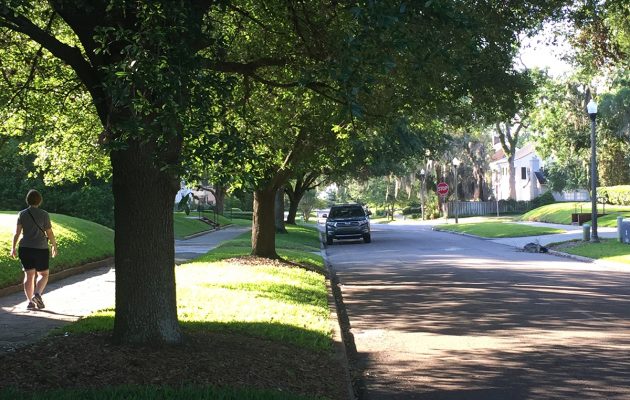Historic tree canopies in danger from over-reactive property owners
Posted on September 1, 2018 By Editor Articles, Neighborhood News, Top Stories

There is perhaps nothing that symbolizes the South – and the historic neighborhoods in Jacksonville – more than live oak trees. Many have survived for centuries; consider Treaty Oak in Jessie Ball duPont Park on the Southbank.
Unfortunately, some live oaks that have provided significant tree canopy for decades are being removed because property owners are fearful of potential damage to their homes from trees because of hurricanes. That preemptive strike doesn’t sit well with one Avondale resident.
“The old growth tree canopy is the very essence of the neighborhood. My concern is that as hurricanes increase and intensify (as a result of global change) the canopy could be destroyed by our residents,” said Pamela Telis, founder of Friends of Boone Park South.
The right tree planted in the right place can add value to property, provide much needed shade and comfort, promote walkability, filter pollution, absorb storm water runoff, and a single live oak can add up to $30,000 value to a property, according to Francis Putz, a botanist at the University of Florida.
Putz also states a live oak planted near a house can act as a windbreak during a hurricane because they are extremely wind-resistant, but Early Piety, a tree specialist who cares for Treaty Oak, said it’s more likely the building will serve to protect the tree. “Live oaks are notoriously tough trees, resilient and handle the wind well, but they are not a windbreak,” Piety said, noting the tall buildings behind Treaty Oak protected it from Hurricane Irma.
For homeowners who are concerned about damage from falling trees, Piety said the more brittle trees, such as sweet gums and maples, are more likely to lose limbs during a storm than a live oak.
For Telis, it’s ironic that property owners are taking such drastic measures at the same time Riverside Avondale Preservation has been conducting a survey to add more trees to the historic district to replenish the canopy by tapping into the $20 million Tree Mitigation Fund.
“Here we are at RAP [and the] City working hard to support and maintain our tree canopy and we have uninformed owners who move into our neighborhood for the tree canopy then get ‘scared’ by tree companies that know little about trees,” said Telis, who wants RAP to review the municipal code and then determine if it meets the goals as a neighborhood and city.
Although the City of Jacksonville does have a permit process for the removal of trees, when properties are single family residences, no permit is required, according to Richard Leon, the City’s Urban Forest Manager.
Since no permit is required, neither is engaging a tree specialist to determine if disease is a reason to take down a shade tree. Property owners can hire a tree removal company, which may or may not have an arborist on staff, to cut down a healthy tree, regardless of its age.
Piety, who owns Specialty Tree Surgeons and is a certified arborist, said it’s hard to tell simply by looking at a tree if it is diseased. “Live oaks are susceptible to a heart rot fungus which makes the limbs hollow, but you don’t know unless you saw it off,” he said.
Some tree specialists will drill into a tree to measure decay with a tool called a resistograph, but Piety prefers to knock on the trunk and listen to determine if it’s become hollow.
Some trees are, however, protected from removal and, in some cases, permits are required.
The “Citizen’s Guide to the City of Jacksonville’s Tree Permit Application Process” indicates permits are required to remove protected trees as well as trees exempt from mitigation fees, which must have evidence of entitlement to exempt the property owner from paying into the Tree Trust Fund.
According to the guidelines, trees located on property which includes a single-family home are exempt from mitigation and can be legally removed. Protected trees on private or public property include those which have a diameter at breast height (DBH) of six inches or more and are located within 20 feet of a street right-of-way; a DBH of eight inches or more located within 10 feet of any other property line, and a DBH of 11.5 inches or more located elsewhere on the property.
To read the tree removal permit guide, click here.
By Kate A. Hallock
Resident Community News




 (No Ratings Yet)
(No Ratings Yet)




